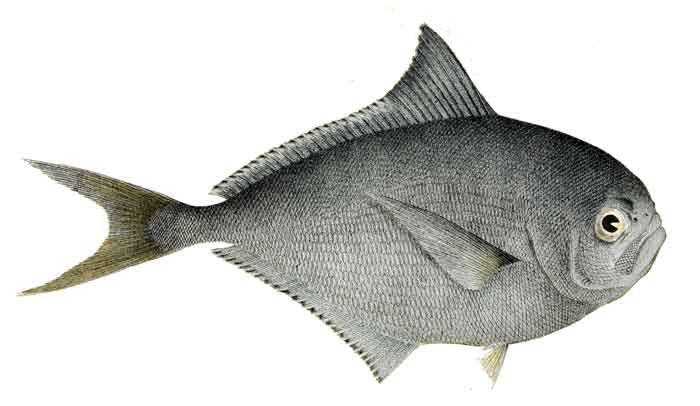
Superregnum: Eukaryota
Cladus: Unikonta
Cladus: Opisthokonta
Cladus: Holozoa
Regnum: Animalia
Subregnum: Eumetazoa
Cladus: Bilateria
Cladus: Nephrozoa
Superphylum: Deuterostomia
Phylum: Chordata
Subphylum: Vertebrata
Infraphylum: Gnathostomata
Megaclassis: Osteichthyes
Superclassis/Classis: Actinopterygii
Classis/Subclassis: Actinopteri
Subclassis/Infraclassis: Neopterygii
Infraclassis: Teleostei
Megacohors: Osteoglossocephalai
Supercohors: Clupeocephala
Cohors: Euteleosteomorpha
Subcohors: Neoteleostei
Infracohors: Eurypterygia
Sectio: Ctenosquamata
Subsectio: Acanthomorphata
Divisio/Superordo: Acanthopterygii
Subdivisio: Percomorphaceae
Series: Pelagiaria
Ordo: Scombriformes
Familia: Bramidae
Genus: Brama
Species: Brama brama
Name
Brama brama, (Bonnaterre, 1788)
Synonyms
Brama chilensis, (Guichenot, 1848)
Brama marina, (Fleming, 1828)
Brama pinnasquamata, (Couch, 1849)
Brama raii, (Bloch & Schneider, 1801)
Brama raji, (Bloch & Schneider, 1801)
Brama rayi, (Bloch & Schneider, 1801)
Brama squamosa, (Hutton, 1875)
Chaetodon umbratus, (Cabrera, 1857)
Lepidotus catalonicus, (Asso, 1801)
Lepidotus chilensis, (Guichenot, 1848)
Lepodus saragus, (Rafinesque, 1810)
Lepodus squamosus, (Hutton, 1875)
Sparus brama, (Bonnaterre, 1788)
Sparus castaneola, (Lacepède, 1802)
Sparus dentatus, (Berkenhout, 1789)
Sparus niger, (Montagu, 1804)
Sparus raji, (Bloch & Schneider, 1801)
Toxotes squamosus, (Hutton, 1875)
Vernacular names
Deutsch: Brachsenmakrele
English: Atlantic pomfret
español: Palometa
galego: Castañeta
hrvatski: Grboglavka
References
fishbase.org
The Atlantic pomfret (Brama brama), also known as Ray's bream, is a species of marine ray-finned fish, a pomfret of the family Bramidae. It is found in the Atlantic, Indian, and South Pacific Oceans, at depths down to 1,000 m (3,300 ft).
Its length is between 40 and 100 cm (16 and 39 in). In South Africa, where it is a common bycatch of the hake fishery, it is generally known and sold as "angelfish", although it is not a true marine angelfish.[3]
The Atlantic pomfret has very significant migration patterns[4] which greatly depend on the temperature of intermediate waters, but are also affected by secondary reactions from density dependence and the climatic conditions of the surface. Although the species was first recorded in Irish waters in 1843, it was still regarded as scarce up until the late 1950s, but between the 1960s and 1970s large numbers were recorded.
References
Iwamoto, T.; Singh-Renton, S.; Robertson, R.; Marechal, J.; Aiken, K.A.; Dooley, J.; Collette, B.B.; Oxenford, H.; Pina Amargos, F.; Kishore, R. (2015). "Brama brama". IUCN Red List of Threatened Species. 2015: e.T195091A19929350. doi:10.2305/IUCN.UK.2015-4.RLTS.T195091A19929350.en. Retrieved 20 November 2021.
Froese, Rainer; Pauly, Daniel (eds.) (2019). "Brama brama" in FishBase. December 2019 version.
"Fish detail". WWF SASSI. Retrieved 2020-11-06.
Quinzán, M.; Castro, José; González, Manuel Marín; Costas, Gersom; Monserrat, S.; Amores, A.; Massutí, E.; Hidalgo, M. (September 2016). "Unveiling the influence of the environment on the migration pattern of the Atlantic pomfret (Brama brama) in North-eastern Atlantic waters". Fisheries Oceanography. 25 (6). Instituto Español de Oceanografia: 610−623. Bibcode:2016FisOc..25..610Q. doi:10.1111/fog.12176. Retrieved 2020-11-06.
Retrieved from "http://en.wikipedia.org/"
All text is available under the terms of the GNU Free Documentation License

